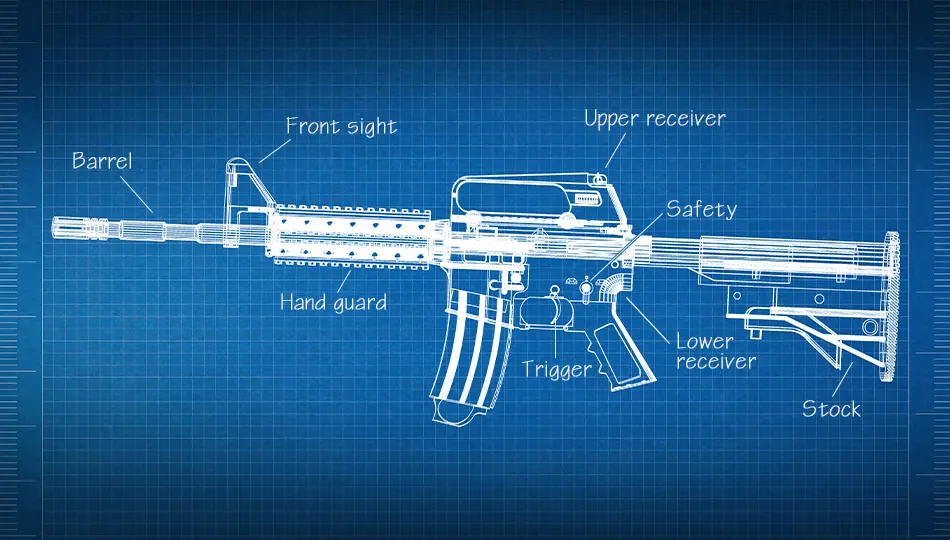
Building AR-15s is often referred to as “Legos® for adults,” and while the general fit-and-create concept applies, there’s a lot more to successfully putting together a reliable firearm than making a Lego tower. When you realize how many parts it takes to build an AR-15—about 65 to 100, depending on configuration—it might seem overwhelming. Consider this your one-stop read to find out what individual components are necessary to build an AR-15.
What Are the Main Parts of an AR-15?
You can break an AR-15 down into its two largest parts, the upper and lower receivers. A complete upper receiver includes the receiver itself, bolt carrier group, handguard, and barrel. Of course, there’s more to it than that; a complete upper receiver has numerous small parts to make the larger pieces work. A stripped upper receiver requires you to install every tiny part.
A lower receiver includes the receiver itself, stock, buffer tube and buffer spring, trigger, safety, and other small parts. It can also be purchased as a complete or stripped lower receiver.
When you clean an AR-15, you separate the two receivers by pushing the takedown pins free so the parts are no longer locked together. You then remove the bolt carrier group from the upper and the buffer weight and spring from the lower to begin cleaning and lubricating your gun.
What Is Needed to Build an AR-15?
Although some people will say you can build an AR-15 with standard wrenches and hammers—which is technically correct—it’s not a good idea. Using the wrong tools to build an AR-15 results in damage to the components, bent pins, and other problems that can stop it from functioning correctly. Aesthetically, it also creates a mess of scratches and dings on what should be your brand-new, pristine gun.
Tools to consider getting before you start the building process:
- Bench vise
- Magazine well vise block
- Reaction or upper receiver rod/barrel rod
- AR-15 torque wrench, 30 lbs to 150 lbs (proper torque matters)
- Armorer’s wrench (check to see if the parts you’re using require a specific, proprietary AR-15 armorer’s wrench)
- Complete punch set (preferably one that includes brass and plastic punches in addition to steel)
- Non-marring brass/nylon hammer
- Hex wrench set
- Torx bit set and handle
- Needle-nosed pliers
Tools that are also nice to consider adding to your collection:
- Gunsmith screwdriver set with magnetic bits
- Roll pin holder/roll pin starter punches
- Roll pin punches (if not part of your original punch set)
- Pivot pin installation tool
- Gun bench mat
- Collapsible buttstock tool (if using collapsible buttstock)
- A2 sight adjustment tool (if using an A2 front sight)
- Breaker bar
- Strap wrench
- Headspace gauge (go/no-go)
Miscellaneous items you may want:
- Loctite® 222 (purple, low-strength)
- Parts can be removed relatively simply using hand tools once applied. Used for smaller parts like set screws.
- Loctite® 243 (blue, medium-strength)
- Parts can be removed using the proper tools once applied. Used for parts like handguard screws or anti-walk pins.
- Loctite® 271 (red, high-strength)
- Extremely difficult to remove parts once applied. Sometimes used for gas block set screws and muzzle devices. Some builders use Rocksett® instead of red Loctite®.
- Anti-seize lubricant (copper-based)
- Used for parts like the barrel nut. Some builders prefer using gun-friendly grease.
- Lubricant
Enjoying this content? Find out how you can get more sent straight to your inbox!
All Parts Needed to Build an AR-15
It takes quite a few parts to build an AR-15. The specific parts for an AR-15 can vary a bit depending on the configuration you’ve chosen, but the basics remain the same. Keep in mind that some components for an AR-15, such as the bolt carrier group, can easily be purchased preassembled.
- Upper receiver (stripped)
- Charging handle (can be purchased as a complete kit)
- Charging handle latch
- Charging handle latch spring
- Charging handle latch roll pin
- Forward assist (if including one; can be purchased as a complete kit)
- Forward assist pawl
- Forward assist pawl detent
- Forward assist pawl detent spring
- Forward assist retaining pin
- Forward assist spring
- Pawl pin
- Ejection port cover/dust cover (can be purchased as a complete kit)
- Ejection port cover pin
- Ejection port cover pin retaining ring
- Ejection port cover spring
- Barrel assembly
- Barrel
- Barrel nut
- Barrel indexing pin
- Crush washer
- Delta ring
- Handguard (associated parts depend on whether it’s free-floating, among other details)
- Front and rear sights if using iron sights (parts associated with front sight are dependent on type of sight you choose)
- Muzzle device (muzzle break, flash hider, )
- Gas tube
- Gas tube roll pin
- Gas block
- Gas block set screws
- Bolt carrier group (can be purchased complete)
- Bolt carrier
- Bolt
- Bolt carrier key
- Bolt carrier key screw (×2)
- Cam pin
- Ejector
- Ejector spring
- Ejector roll pin
- Extractor
- Extractor spring
- Extractor pin
- Firing pin
- Firing pin retaining pin
- Gas rings (×3)
- Lower receiver (stripped)
- Lower parts kit (parts can be purchased as individual components, but complete kits are widely available)
- Bolt catch
- Bolt catch plunger
- Bolt catch roll pin
- Bolt catch spring
- Buffer retainer
- Buffer retainer spring
- Disconnector
- Disconnector spring
- Hammer
- Hammer pin
- Hammer spring
- Magazine catch
- Magazine catch button
- Magazine catch spring
- Pistol grip
- Pistol grip lock washer
- Pistol grip screw
- Pivot pin
- Pivot pin detent
- Pivot pin detent spring
- Selector
- Selector detent
- Selector detent spring
- Takedown pin
- Takedown pin detent
- Takedown pin detent spring
- Trigger (can be one-piece, drop-in style, or assorted parts that must be assembled)
- Trigger guard (if the lower doesn’t have one)
- Trigger guard roll pin
- Trigger pin
- Trigger spring
- Charging handle (can be purchased as a complete kit)
- Stock assembly
- Stock (collapsible stocks require more parts and can be purchased complete or with individual components)
- Buffer weight
- Buffer spring
- Buffer tube
- Castle nut
- Receiver end plate
- Receiver extension
- Receiver extension nut
- Aftermarket parts to consider:
- Bipod
- Foregrip
- Optics (riflescope or red dot sights)
- Optics mount and associated parts
- Laser
- Magazines
- Sling
- Quick Detach (QD) sling mount or rings
- Trigger, drop-in or otherwise customized
- Vertical grip
- Weapon mounted light (WML)
How Long Does It Take to Build an AR-15?
The length of time it takes to build an AR-15 depends on your experience and the parts involved. Purchasing complete receivers that have all the individual components already installed saves a lot of time, but that isn’t considered “building” so much as “assembling.” Stripped receivers require the builder to install every pin, screw, and part.
When you’re a new AR builder, it may take you all day to build an AR-15. Once you get the hang of it, building an AR-15 can be accomplished rather quickly, perhaps within a couple of hours. It’s even possible to build an AR-15 within an hour, although that tends to involve less attention to detail.
Is It Cheaper to Build an AR-15 or Buy an AR-15?
Whether it’s cheaper to build an AR-15 or buy an AR-15 depends on the specific gun. AR components come in a wide range of styles with varying quality. For example, you might find an inexpensive, basic bolt carrier group for $50 while a titanium, gas-regulated model could cost more than $300. It’s possible to build an AR-15 without straining your bank account, but you could also spend quite a bit of money very easily.
When you’re trying to decide if it’s worth it to put the time and money into building your own AR-15, it’s all about priorities. First, consider what you need the AR-15 to do. Is it for hunting, home defense, or general range use? Second, decide how long you’d like the gun in question to last. Be realistic about your AR budget, but understand odds are high you’ll end up spending more money than you originally expected. High-quality components can be well worth it, but many expensive AR-15 parts are nothing but gimmicks, so take the time to do some research.
Is an Upgraded Trigger for an AR-15 Worth the Money?
Many gun owners are happy with standard AR-15 trigger assemblies. These are the type you see in lower parts kits that require you to assemble the springs and other individual components into a functioning trigger. Aftermarket triggers, such as those that are drop-in cassettes or that require assembly but include specific spring weights and trigger shoes, are excellent options for many shooters. Having an aftermarket or higher-end trigger gives you the freedom to fit the trigger to your own hand size and fingers. It also means choosing your trigger pull weight, which is a nice thing to have control over.
Why Should I Build My Own AR-15?
Aside from the fact that building your own AR-15 can be fun, it’s a good learning experience. By putting an AR-15 together from scratch, you have the opportunity to learn how every tiny component fits and functions. That can go a long way toward learning how to troubleshoot and repair your gun. Also, the more you know about how AR-15s work, the more effectively you can run them
Your Protection Starts Here!
The information provided in this publication is intended to provide general information to individuals and is not legal advice. The information included in this publication may not be quoted or referred to in any other publication without the prior written consent of U.S. LawShield, to be given or withheld at our discretion. The information is not a substitute for, and does not replace the advice or representation of a licensed attorney. We strive to ensure the information included in this publication is accurate and current, however, no claim is made to the accuracy of the information and we are not responsible for any consequences that may result from the use of information in this publication. The use of this publication does not create an attorney-client relationship between U.S. LawShield, any independent program attorney, and any individual.





Leave A Comment